We’re continuing our look behind the scenes of Star Trek’s visual effects, focusing this time on a Star Trek: Voyager Season Four favorite, “Scientific Method“!
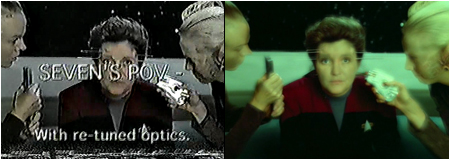
As with the previous entries in this exclusive video series, we’ve got a full before-and-after video comparison below, and TrekCore contributor Justin Olson provides scene-by-scene breakdowns of the technical processes used to complete each effect – along with some additional commentary by Voyager Senior CG Supervisor Robert Bonchune!
We have used two versions of “Scientific Method” in this presentation: a production-era workprint VHS tape dated September 10, 1997, and the completed version of the episode included in the 2004 DVD release.
![]()
| 1997 Workprint | 2004 DVD |
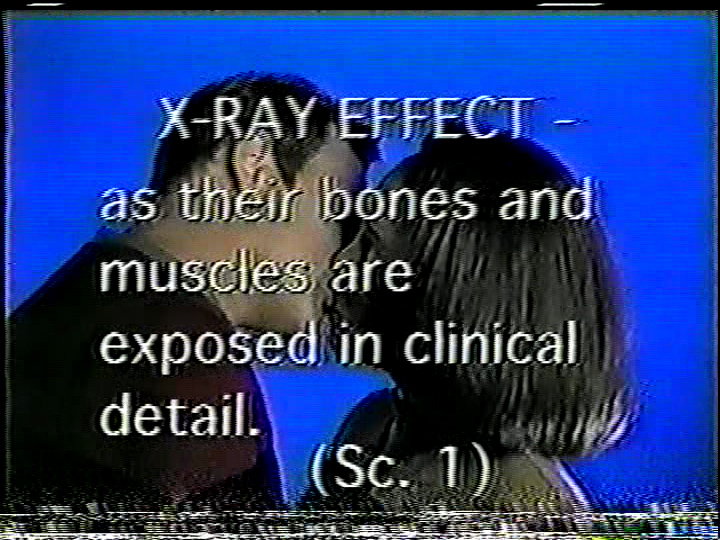 |
 |
|
TEASER, SCENE 1: In the workprint, Paris and Torres (Robert Duncan McNeill and Roxann Dawson) are filmed separately in front of bluescreen. Foundation Imaging’s artists created an X-Ray effect animation utilizing CG models of Paris’ and Torres’ skeletons with some visible musculature. The footage and animation are superimposed together, composited with a suitable background plate of the Jefferies Tube intersection. The completed Srivani scanning effect adds a rippling “frosted glass” distortion to the footage as well as a feathered area where the inner anatomy can be seen which scans up and down. Also added is a HUD (heads-up display) interface with Srivani data to give the impression that this is a POV shot of some kind. The angle then subtly changes as Torres gets the feeling they are being watched. |
|
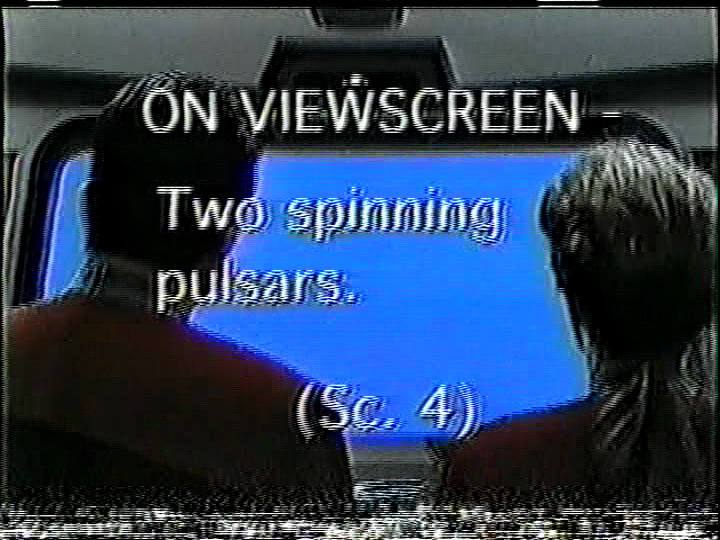 |
 |
|
ACT ONE, SCENE 4: In the workprint, the foreground plate is used of Chakotay and Janeway (Robert Beltran and Kate Mulgrew) on the bridge filmed against bluescreen. In the finished shot, the blue color is “keyed out” and a traveling matte created, a sort of silhouette of the actors which allows their image to remain while the viewscreen area becomes transparent to the footage behind it – in this case, CG animation provided by Foundation Imaging of the binary pulsars. |
|
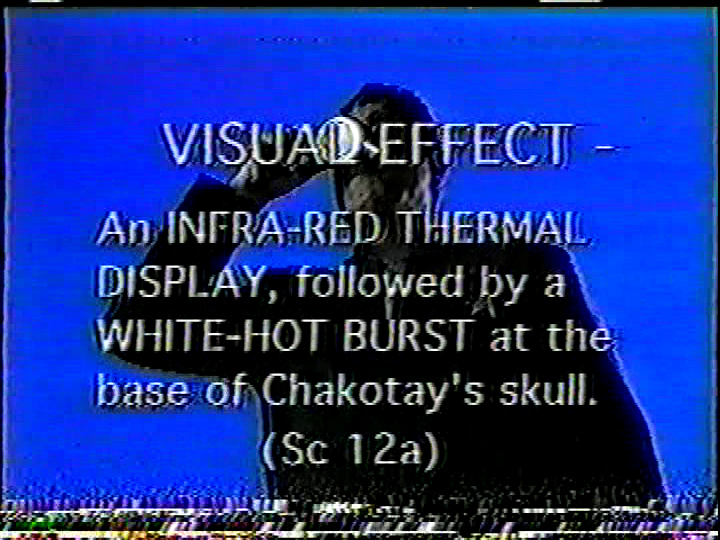 |
 |
|
ACT ONE, SCENE 12A: In the workprint, Robert Beltran is filmed separately in front of bluescreen. In similar fashion to Scene 1, Foundation Imaging’s artists created an infrared effect animation utilizing a CG model of Chakotay’s inner anatomy, focusing primarily on his digestive system and the coffee that pours down his esophagus and into his stomach. The footage and animation are superimposed together and composited with a suitable background plate of Chakotay’s quarters. The overall look of the Srivani scanning effect differs somewhat here, but retains the HUD interface text readouts. A white-hot burst effect is added at the base of Chakotay’s skull to coincide with Beltran’s reaction in the scene. |
|
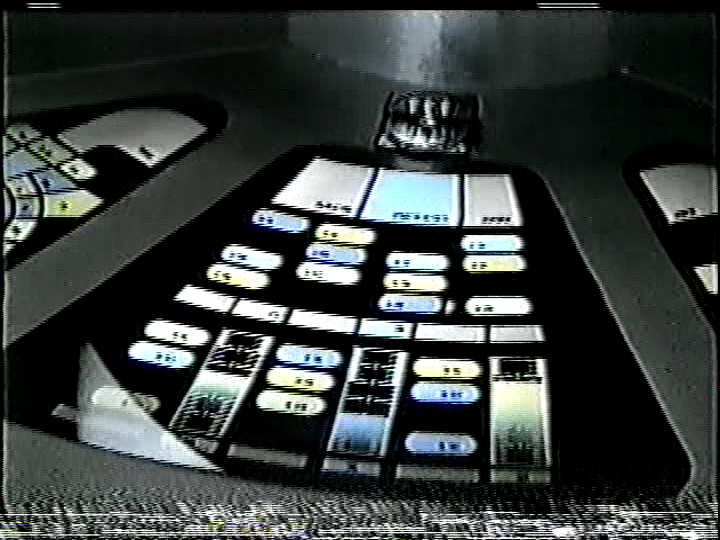 |
 |
|
ACT TWO, SCENE 18: In the workprint, the science lab console merely has practical (and static), backlit elements courtesy of the art department. However, the script calls for an animated graphic or “Okudagram” of a DNA segment sending out a short range signal via the Srivani molecular tags. Mike Okuda and his team created these animations – in what look to be two separate areas above and below the midline of the back-lit element – and they were simply composited on top of the footage. |
|
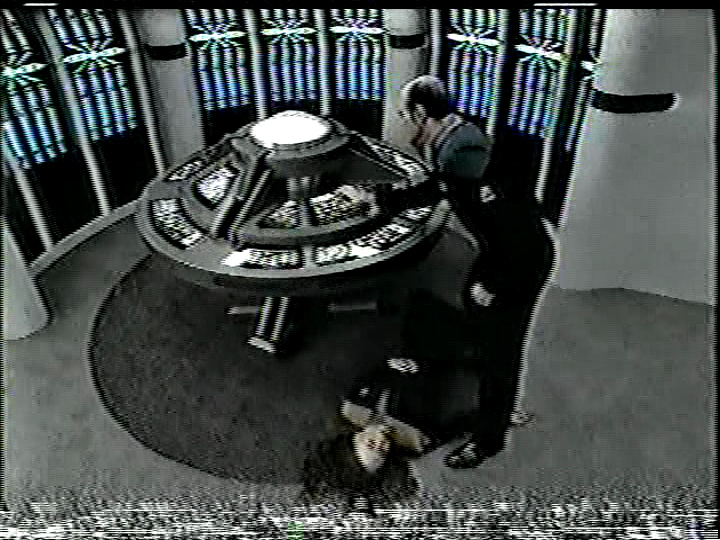 |
 |
|
ACT TWO, SCENE UNKNOWN: Here we have a locked-off shot which allows a couple subtle effects to play out rather effectively. In the workprint, we can see that the action of Torres collapsing in pain and losing consciousness and the Doctor coming to her aid were filmed first. Then, Robert Picardo walked out of the shot and Roxann Dawson had to lie perfectly still for several seconds so the VFX artists would have a clean plate in which to erase the Doctor. The workprint simply has him blink out momentarily then eventually dissolve away. In the finished shot, a custom, semi-transparent hold-out matte was created by an artist in the shape of the Doctor. This matte partially “holds-out” the background, allowing the alternating pattern of vertical streaks to be seen through his body which simulate the malfunctioning of the mobile emitter. Similarly, when the Doctor transfers himself to the Holodeck, a subtle distortion effect with a dissolve removes him from the shot. His mobile emitter prop is then filmed separately from the same camera position and dropped from the same height, with an artist likely painting-in its shadow to complete the effect. |
|
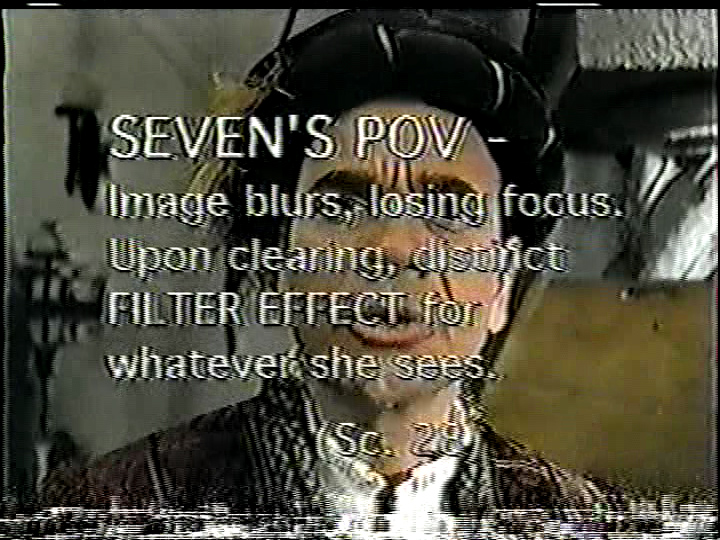 |
 |
|
ACT THREE, SCENE 28: In the workprint, the Doctor (Robert Picardo) is filmed from what would be Seven’s (Jeri Ryan’s) POV. The panning footage is treated to simulate what she sees: the image is distinctly tinted “Borg green” and intentionally smeared and blurry with a pincushion-like effect and a subtle varying distortion. |
|
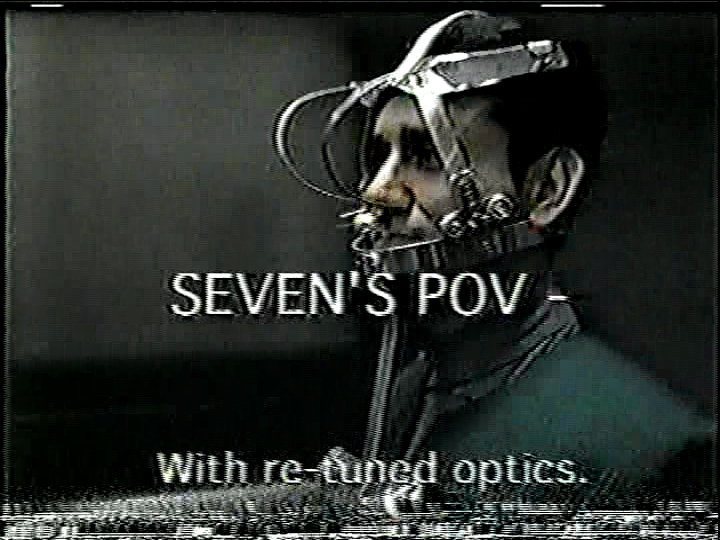 |
 |
|
ACT THREE, SCENES UNKNOWN: More of Seven’s POV. The background actors are filmed with the grotesque-looking Srivani devices on their bodies and the footage is treated with the same pincushion effect, green Borg hue and subtle distortion. |
|
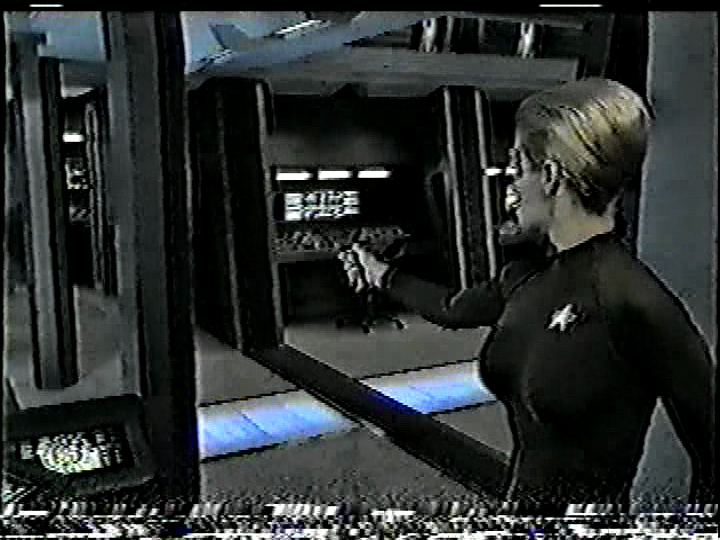 |
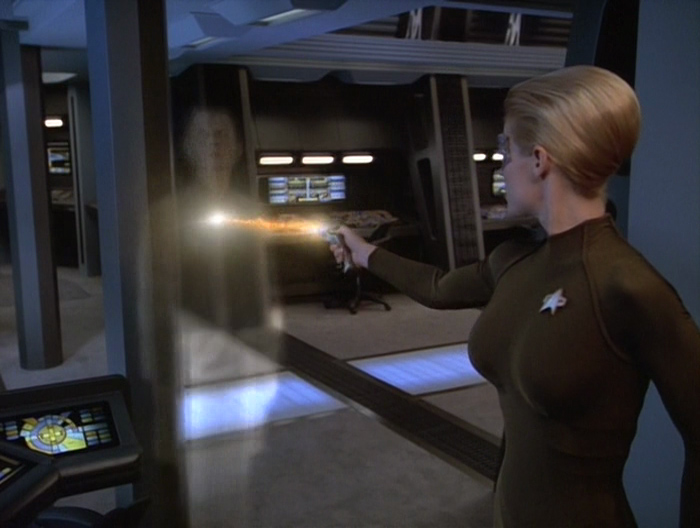 |
|
ACT FOUR, SCENE UNKNOWN: Seven grabs Tuvok’s (Tim Russ’) phaser and shoots at one of the Srivani intruders. In the workprint, the intruder (named Alzen in the script and played by Rosemary Forsyth) simply cross dissolves into view. In the completed shot, the phaser beam is added along with an energy effect that is reminiscent of a transporter beam-in. A semi-transparent hold-out matte is created by an artist in the shape of the actor. This matte “holds-out” the background to allow the effect to be seen just inside the body. The effect is comprised of a blurred interior of the alien’s body and tendrils of green energy along with two vertical streaks which converge, deflect off of one another and disperse, then slowly dissolve away. |
|
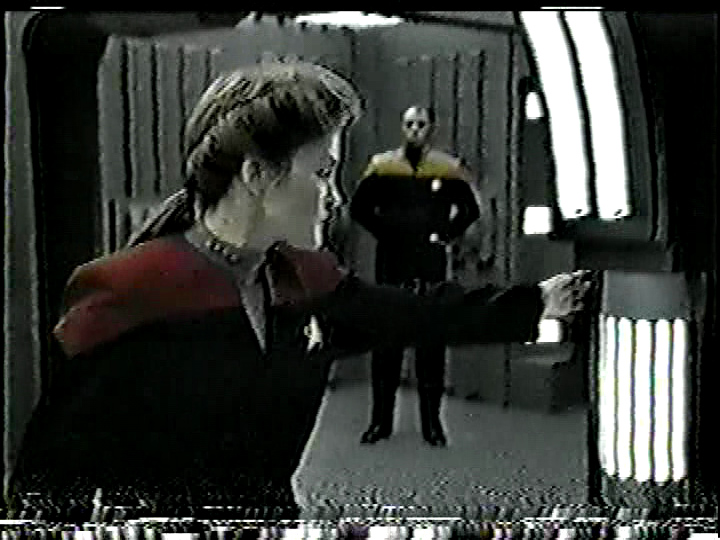 |
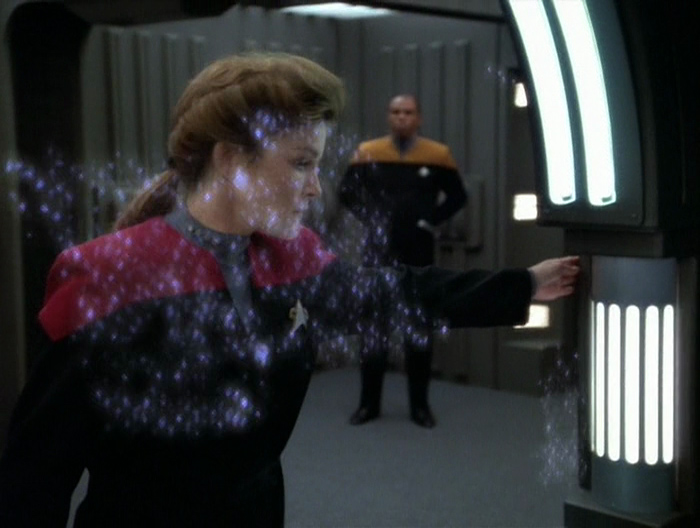 |
|
ACT FOUR, SCENE UNKNOWN: The brig’s force field effect appears here in a pattern of sparkles reminiscent of the third stage of the transporter effect originally produced by Rick Zettner & Associates, Inc. for the TNG pilot “Encounter at Farpoint“. Two identical areas (one inverted) appear over Janeway’s body and expand in size, then dissipate while other areas come to life intermittently before also disappearing. |
|
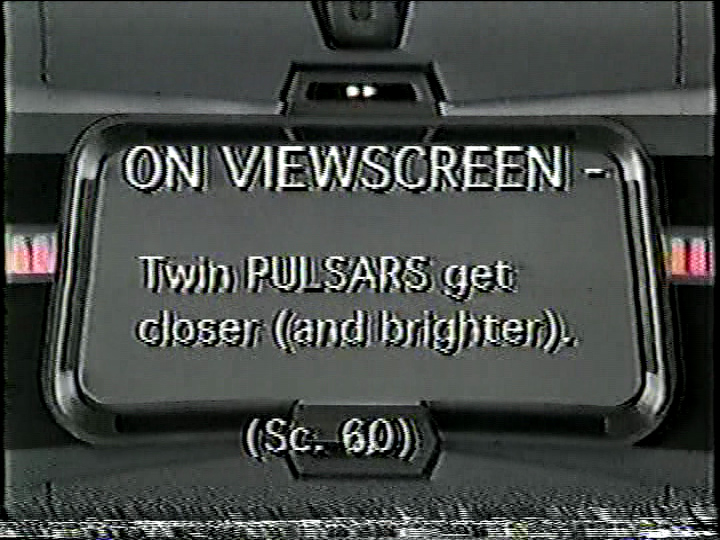 |
 |
|
ACT FIVE, SCENE 60: Similar to Scene 4 but without the requirement of bluescreen (because no actors were filmed in front of it and hence no traveling matte was needed) the foreground plate of the viewscreen is composited with CG animation provided by Foundation Imaging of the binary pulsars as they get brighter and closer to the ship. |
|
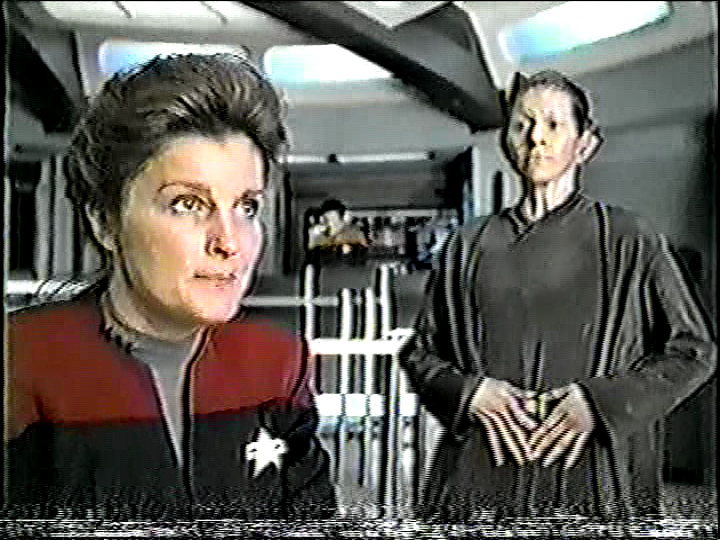 |
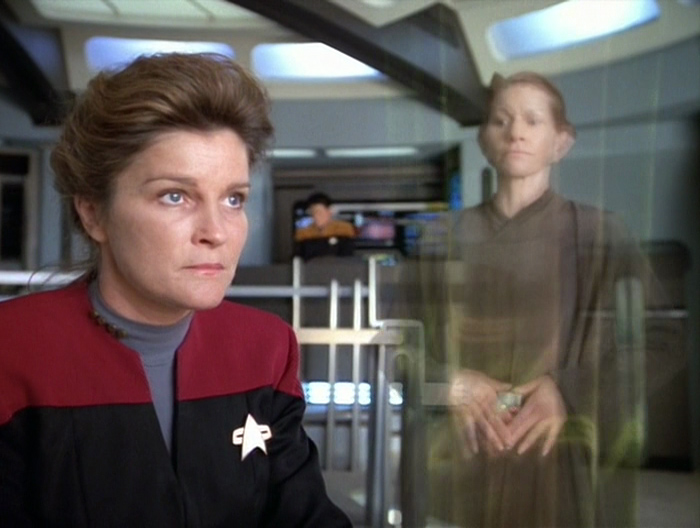 |
|
ACT FIVE, SCENE 60 (con’t.): In the workprint, the Srivani leader (named Takar in the script and played by Annette Helde) simply dissolves away. In the completed shot, her beam-out effect occurs in a manner essentially identical to Alzen’s appearance in Engineering. . . . |
|
Star Trek: Voyager Senior CG Supervisor Robert Bonchune (whom we spoke to back in May regarding Deep Space Nine‘s visual effects) won a host of Emmys for his CG work on several episodes (including Voyager‘s “Dark Frontier” and “Endgame“) gave us his thoughts on the effects featured in “Scientific Method” – after all, he helped put them together!
On CG skeletons: “In terms of the skeleton and muscles animations and all that, well, they weren’t easy – John Teska did those shots, and had to build and texture the inner muscles and bones… and then eyeball match/move things to match the actors performance. Straightforward, but long and hard detailed work.”
On binary stars: “It was of one of the first effect things I did for Voyager – the binary star system with the accretion disc around them, with the odd tendril-like extensions inwards instead of a solid ring like Jupiter. I remember it was a bit tricky to do back then, now I wouldn’t even break a sweat!”
On climactic finale: “The bigger effect was the ships suction-cupped to Voyager, which finally “uncloak” and remove themselves from the hull before getting burned in the plasma the ship was flying through. That was a tough bit, and I wanted a sequence like the [Praxis shock wave] which hit the the Excelsior at the beginning of Star Trek: VI – obscuring clouds of plasma, and energy racing by the hull and over it. I still remember how I did it without using any volumetrics, which we just could not back then (although it might have been more ideal). Still, I was happy at the time with what I came up with.”
![]()
TrekCore’s special Voyager Week isn’t over yet – stick around for tomorrow’s special article profiling the forgotten gems in Star Trek Voyager merchandise. Don’t miss it!

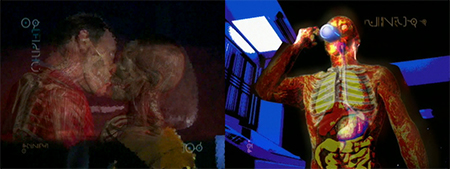
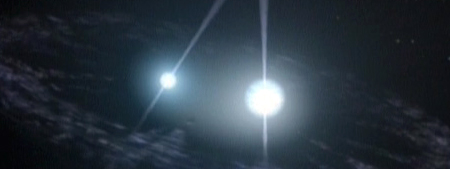
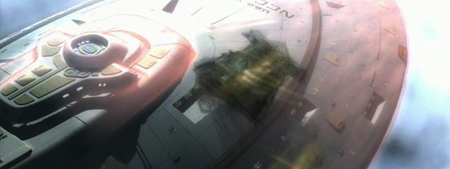
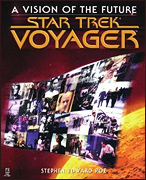 Star Trek: VoyagerA Vision of the Future
Star Trek: VoyagerA Vision of the Future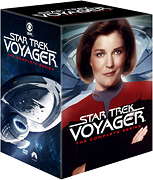 Star Trek: VoyagerComplete Series on DVD
Star Trek: VoyagerComplete Series on DVD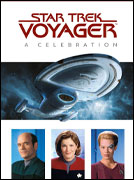 Star Trek: VoyagerA Celebration
Star Trek: VoyagerA Celebration